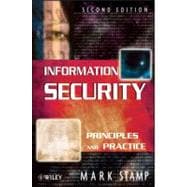
Note: Supplemental materials are not guaranteed with Rental or Used book purchases.
Purchase Benefits
Looking to rent a book? Rent Information Security Principles and Practice [ISBN: 9780470626399] for the semester, quarter, and short term or search our site for other textbooks by Stamp, Mark. Renting a textbook can save you up to 90% from the cost of buying.
About The Author.
Acknowledgments.
1 Introduction.
1.1 The Cast of Characters.
1.2 Alice’s Online Bank.
1.3 About This Book.
1.4 The People Problem.
1.5 Principles and Practice.
1.6 Problems.
I Crypto.
2 Crypto Basics.
2.1 Introduction.
2.2 How to Speak Crypto.
2.3 Classic Crypto.
2.4 Modern Crypto History.
2.5 A Taxonomy of Cryptography.
2.6 A Taxonomy of Cryptanalysis.
2.7 Summary.
2.8 Problems.
3 Symmetric Key Crypto.
3.1 Introduction.
3.2 Stream Ciphers.
3.3 Block Ciphers.
3.4 Integrity.
3.5 Summary.
3.6 Problems.
4 Public Key Crypto.
4.1 Introduction.
4.2 Knapsack.
4.3 RSA.
4.4 Diffie-Hellman.
4.5 Elliptic Curve Cryptography.
4.6 Public Key Notation.
4.7 Uses for Public Key Crypto.
4.8 Public Key Infrastructure.
4.9 Summary.
4.10 Problems.
5 Hash Functions++.
5.1 Introduction.
5.2 What is a Cryptographic Hash Function?
5.3 The Birthday Problem.
5.4 A Birthday Attack.
5.5 Non-Cryptographic Hashes.
5.6 Tiger Hash.
5.7 HMAC.
5.8 Uses for Hash Functions.
5.9 Miscellaneous Crypto-Related Topics.
5.10 Summary.
5.11 Problems.
6 Advanced Cryptanalysis.
6.1 Introduction.
6.2 Enigma.
6.3 RC4 as Used in WEP.
6.4 Linear and Differential Cryptanalysis.
6.5 Lattice Reduction and the Knapsack.
6.6 RSA Timing Attack.
6.7 Summary.
6.8 Problems.
II Access Control.
7 Authentication.
7.1 Introduction.
7.2 Authentication Methods.
7.3 Passwords.
7.4 Biometrics.
7.5 Something You Have.
7.6 Two-Factor Authentication.
7.7 Single Sign-On and Web Cookies.
7.8 Summary.
7.9 Problems.
8 Authorization.
8.1 Introduction.
8.2 A Brief History of Authorization.
8.3 Access Control Matrix.
8.4 Multilevel Security Models.
8.5 Compartments.
8.6 Covert Channel.
8.8 CAPTCHA.
8.9 Firewalls.
8.10 Intrusion Detection Systems.
8.11 Summary.
8.12 Problems.
III Protocols.
9 Simple Authentication Protocols.
9.1 Introduction.
9.2 Simple Security Protocols.
9.3 Authentication Protocols.
9.4 Authentication and TCP.
9.5 Zero Knowledge Proofs.
9.6 The Best Authentication Protocol?
9.7 Summary.
9.8 Problems.
10 Real-World Security Protocols.
10.1 Introduction.
10.2 SSH.
10.3 SSL.
10.4 IPSec.
10.5 Kerberos.
10.6 WEP.
10.7 GSM.
10.8 Summary.
10.9 Problems.
IV Software.
11 Software Flaws and Malware.
11.1 Introduction.
11.2 Software Flaws.
11.3 Malware.
11.4 Botnets.
11.5 Miscellaneous Software-Based Attacks.
11.6 Summary.
11.7 Problems.
12 Insecurity in Software.
12.1 Introduction.
12.2 Software Reverse Engineering.
12.3 Digital Rights Management.
12.4 Software Development.
12.5 Summary.
12.6 Problems.
13 Operating Systems and Security.
13.1 Introduction.
13.2 OS Security Functions.
13.3 Trusted Operating System.
13.4 Next Generation Secure Computing Base.
13.5 Summary.
13.6 Problems.
Appendix.
A-1. Network Security Basics.
A-2. Math Essentials.
Annotated Bibliography.
Index.
The New copy of this book will include any supplemental materials advertised. Please check the title of the book to determine if it should include any access cards, study guides, lab manuals, CDs, etc.
The Used, Rental and eBook copies of this book are not guaranteed to include any supplemental materials. Typically, only the book itself is included. This is true even if the title states it includes any access cards, study guides, lab manuals, CDs, etc.